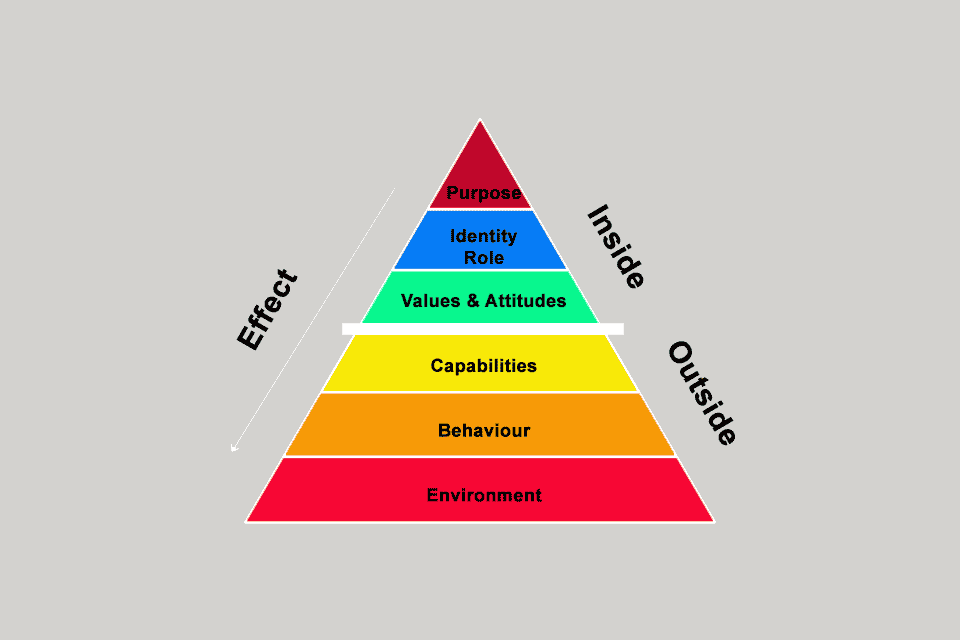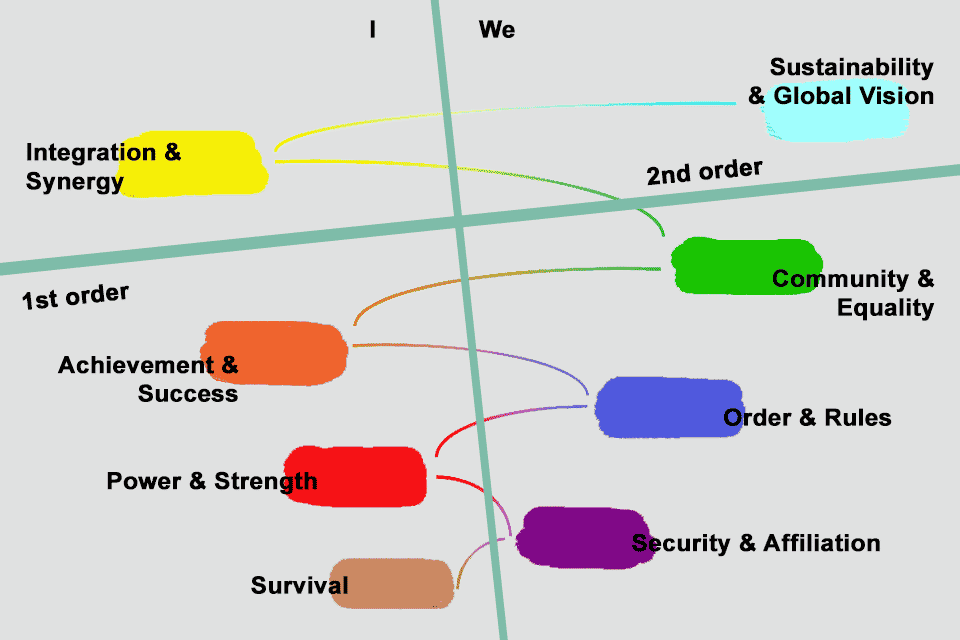Working with agile values
Do you think that everyone in your organisation understands courage in the same way? Can you imagine that openness and respect can be in competition? And how much openness is still respectful?
Courage, openness and respect as well as focus and commitment – these are five values that are mentioned in the Scrum Guide1 and regularly addressed in the course of agile transformation projects. However, my personal experience with value discussions is ambivalent, because these values are often discussed, lived and yes, sometimes abused in very different ways. Values cannot simply be changed in training courses and seminars in order to achieve better results together. Those who seriously want to deal with values of employees in organisations are welcome to delve a little deeper into the topic.
The Dilts Pyramid – the model of logical levels
The Dilts Pyramid was developed by Robert Dilts2. As an explanatory model for change processes, the pyramid is based on two ideas:
- The dynamics of change in people and organisations are characterised by six levels that build on each other.
- The levels work from top to bottom, i.e. if you want to achieve a change on one level, you should ideally intervene on the level above.
The lowest level is the environment. It defines the context and can be accessed through questions such as “When”, “Where” or “With whom”.
The next level describes the behaviour. This depends on the context and becomes visible through questions about “what”.
On the next level are capabilities. Even if, in contrast to environment and behaviour, these are not visible to everyone at all times, they can usually be defined well from the outside.
The next level comprises values and attitudes. These values and attitudes represent, for example, inner beliefs and aspects that are important for an individual and therefore also show up in individual behaviour.
At the level of identity and role, both the self-image and the perception of others are expressed, whereby the self-image can deviate from the external image.
The top of the pyramid is the purpose – in some visualisations, the goal is also represented. The purpose provides the answer to the question “what for” and reflects, for example, the purpose of a team or an organisation.
If you follow this model, it quickly becomes clear that a change of values in the course of an agile transformation must fail if the participants are unclear about their own roles and do not recognise the purpose of the project. And even if the purpose is understood, this does not mean that the values of those involved can also be adapted. Clare W. Graves has described the reasons for this.
Personality development via levels of consciousness and value systems
Clare W. Graves was an American professor of psychology and colleague of the famous motivational researcher Abraham Maslow. He is the founder of the level theory of personality development, which was later developed further by Don Edward Beck and Christopher C. Cowan into the Spiral Dynamics Model3 and transferred to the development of teams and corporate cultures by Frederic Laloux in the book “Reinventing Organizations”4.
Graves’ Model5
addresses the development of the personality and the evolution of cultures and organisations. Specifically, it describes the development of levels of consciousness in the course of a person’s life, whereby each level of consciousness is shaped by different value systems – each of which contains a set of individual values. For example, the values “order” and “control” are typical in a hierarchical value system, whereas “prestige” and “reward” tend to play a role in a performance-oriented strategic value system.
People, teams and corporate cultures always integrate new value systems in their development. The values of a new level of consciousness are comparatively more present in thinking and acting. The values of a level that has already been lived through remain present, but their interpretation undergoes a corresponding change. People live through the different value systems up to an individual level on their way from newborn to old age. Depending on
- the personal circumstances of life,
- education,
- social status and
- the society in which one lives,
values are formed differently.
What people perceive as wealth, for example, depends on where they were born and raised. Adhering to rules is essential for survival in some areas, whereas in another environment the rules are at least questioned. Accordingly, aspects such as origin, culture, beliefs and life circumstances must also be taken into account when considering values.
The developmental levels of the value systems
In the development of our levels of consciousness, we oscillate between the ego and the we perspective:
- hunger,
- thirst,
- fatigue,
- well-being,
- etc.
It is about survival and staying healthy.
We evolve and recognise our tribe, our family. On the purple level of consciousness of “security and affiliation” we recognise that survival in a group is much easier and safer than roaming around alone. Values like
- belonging,
- rituals,
- seniority,
- consistency
are at the centre of action here.
The discovery of one’s own will and becoming self-aware takes place on the red level of consciousness “power and strength” and expresses itself very clearly in the age of defiance. Here we do everything we can to push through our ideas immediately and against all odds. We discover values such as
- courage,
- power,
- bravery,
- assertiveness
as driving forces.
In the long run, however, it is very exhausting to always go forward energetically and so we develop further to the blue level of consciousness “order and rules”. Everything is clearly and transparently regulated. If I obediently fulfil my tasks, the path is clearly predictable. There is one truth and it is law. Our values are
- discipline,
- order,
- stability,
- perseverance.
This ability to plan and predict gives us security.
Sometimes it makes sense to question rules and look for new, innovative solutions. Having reached puberty, we discover the orange level of consciousness “achievement and success” for ourselves. Winning is the ultimate goal. Associated with this are values such as
- status,
- productivity,
- competition,
- prosperity,
- reward,
- excellence.
The realisation that profit maximisation at all costs leads to predatory capitalism brings the green level of consciousness of “community and equality” into our lives. It is no longer just about winning, but about strengthening community and caring for ourselves and our environment as equals. With it go values like
- fairness,
- harmony,
- human rights,
- solidarity,
- community spirit
are associated with each other.
The first six levels of consciousness belong to the so-called first order and oscillate between the “I” and “we” perspectives.
People integrate the values of the levels of consciousness they have already passed through. However, the understanding of a value changes in the course of the different levels, as if one were looking at the individual situations with different coloured glasses. Courage is already understood as a driving force on the third level, but changes its meaning in the further value systems. For people in the rule-based blue value system, courage stands for a perspective such as “I stand up for our rules against doubters of order!”. For a person with a pronounced performance-oriented orange value system, on the other hand, courage means, “I measure myself against my competitors and strive for victory!” And in the egalitarian green value system, in turn, courage can mean asking everyone for their opinion and listening to them, regardless of whether you like their opinions.
All levels of consciousness of the first order understand the other value systems, but only their own interpretation of the value is “correct”.
The second-order levels of consciousness and their value systems postulate an integrative understanding. The struggle of being “right” dissolves and a postmodern, pluralistic consciousness emerges. The first six levels are re-experienced on a global and integral level.
The yellow level of consciousness “integration and synergy” stands for orientation towards knowledge, multiple realities and curiosity. Here people seek a pragmatic way to create synergy effects and not live at the expense of others. The ability to take into account different perspectives and to accept them with a certain serenity, without status consciousness, develops. New competencies are recognised and developed. Values emerge such as
- intuition,
- creativity,
- lifelong learning and
- independence.
Both the turquoise level of consciousness and the coral level are currently not very well represented in society and often lead to confusion in discussions, so I will not go into more detail about them in this blog article.
What does all this have to do with agile values?
When we look at organisations, we naturally find completely different value systems among employees, teams and departments. The assumption of explaining to the people in the organisations that their actions in future will be based on the attitude of agile values such as
- openness,
- commitment,
- focus,
- courage and
- respect
should be shaped out of and thus everything and everyone is clear, is a fallacy. There will almost always be different interpretations of the values and this often leads to conflicts in practice. Why? Because everyone – seen from the respective perspective – is always right.
Conclusion
Personally, I find it invasive to want to change people and their values. Every person is good the way they are and where they stand. Picking out five values, as the Scrum Guide does, does not make much sense to me.
Of course, employees of an organisation may receive concrete offers, e.g. to create a common vision or to use opportunities for self-reflection and personal development. However, the willingness to make use of such offers must be voluntary and must not be demanded.
The pyramid described by Robert Dilts and the level theory of personality development by Clare W. Graves have helped me to understand my fellow human beings better and to treat them with due respect and empathy. And that is a great value for me.
Notes (some in German):
[1] Scrum Guide
[2] Wikipedia: Robert Dilts
[3] Don Edward Beck, Christopher C. Cowan: Spiral Dynamics – Leadership, Werte und Wandel
[4] Frederic Laloux: Reinventing Organizations
[5] Das Graves-Modell. Eine etwas andere Sicht auf die Entwicklung von Organisationen.
If you are interested in more specialist articles from the areas of AI, agile methods, test automation and business process management, then feel free to take a look at the viadee Unternehmensberatung AG blog. It’s worth it! And if you like this article, feel free to share it with your network.
Claudia Simsek-Graf has published another article in the t2informatik Blog:

Claudia Simsek-Graf
Claudia Simsek-Graf studied technical computer science and has worked in IT projects for more than 25 years. Through her previous tasks as a team and department manager, she knows the challenge of dealing with human factors and economic conditions from her own experience. As a business mediator and organisational developer, it is her great passion to accompany the development of people and teams.


